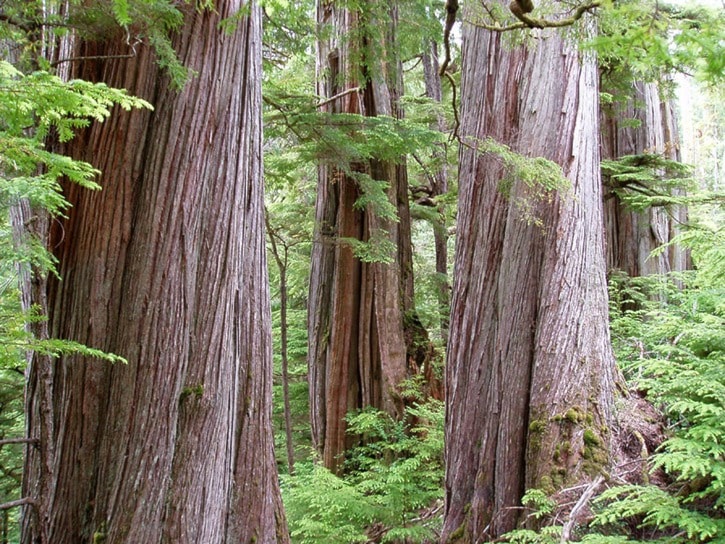Calls for clear, public, cutblock-level logging plans came from all sides during a BC Timber Sales meeting in Port Clements last week.
Daryl Sherban, area forester for BC Timber Sales, said concern over a lack of public engagement is one reason why he and other BCTS staff held the meeting, which included an overview of its planned timber sales for 2017 and 2018.
Sherban also noted that the four major forest licensees on Haida Gwaii — Taan, Husby, Teal Jones, and BCTS — need to renew their shared Forest Stewardship Plan by next January.
That plan will go to public review at meetings in Queen Charlotte, Sandspit, and Port Clements later this month. It is only the second such plan since the Haida Gwaii land-use order was agreed in 2010.
“Everything stems from that agreement,” said Sherban, noting that Haida Gwaii’s land-use rules were made after significant community planning and the creation of the Haida Gwaii Management Council — an oversight body co-managed by B.C.and the Haida Nation.
The HGMC sets the annual allowable cut for Haida Gwaii, and hosted a public forestry forum in 2015.
Still, Sherban agreed that more should be done to keep islanders informed.
“There was a lot of work done with the community-planning forums and everything in the past, and I think everybody kindof patted themselves on the back,” he said.
“There’s been a bit of a lag, I think, dealing with the public and getting feedback.”
Local biologist Kiku Dhanwant said the HGMC forum ran on weekdays, making it hard for people not directly involved in forestry management to join.
More importantly, she said, the plans that are publicly available are not done at the cutblock level where, for example,people might notice how a local creek might be affected.
“It’s all about scale,” she said.
“People don’t know when the cutblocks are going to be coming up for logging.”
Randy O’Brien, president of O’Brien & Fuerst Logging, said the same is true for the islands’ small-scale forestry companies.
“Even we hardly know what’s coming up for logging, with $20 million of equipment and 150 people dependent on it,” he said.
Owned by the province, BCTS is not a typical forestry company.
It sells timber mainly to give the B.C. government market pricing data that is used to set stumpage rates for other licensees,and to meet the terms of the U.S./Canada softwood lumber agreement — an agreement that is now being challenged in theU.S.
With 20 per cent of the annual cut across B.C., BCTS also brings in about $40 million in provincial revenue.
Over the last decade, nearly all its timber here has been auctioned to companies with local workers: O’Brien & Fuerst, Abfam, Taan, Husby, and Infinity West.
BCTS is allowed about 19 per cent of the annual 929,000 cubic metres of timber that can be cut on Haida Gwaii.
But in the last five years, BCTS has only sold about 84 per cent of its available cut, in part because it is following a voluntary limit on cedar harvest recommended by the Chief Forester.
Regarding the harvest of cedar, Doug Daugert, the acting mayor of Port Clements, asked why BCTS has logged so much of its cedar from along the Highway 16 corridor in recent years.
“My concern for the community of Port Clements is, why aren’t we having more of a trickle of wood where there is a long,easy access open to the communities?” he asked.
“I would like to see those more spaced out, and supporting small businesses.”
Sherban said that even five years ago, no one imagined that cedar prices would rise high enough to make it affordable to harvest those cedar-dominant stands, which are in many places surrounded by muskeg.
“When opportunity is there, it would be irresponsible not to take advantage at some level,” he said, noting that cedar nearWatt Lake and similar areas is also regrowing faster than many expected.
But Sherban also said it is very challenging right now to balance the cycle of where and when cedar or any second-growth is harvested.
“Because of past practices and the way things were done, there’s an imbalance,” he said.
“It’s going to take quite a while to get areas like Sewell Inlet back in the game.”
People at the BCTS meeting also asked for an update on plans for a Haida Gwaii community forest — an idea first proposed over a decade ago.
One woman said it seems like the “never never plan.”
Tom Johnson, the regional woodlands manager for BCTS, said the plans have been delayed by a series of staff and board member changes on island, recent court rulings on First Nations title, and the unique nature of the offer to Haida Gwaii.
The Misty Isles Economic Development Society was provisionally offered 80,000 cubic metres a year — the average B.C.community forest gets about 25,000 — but only if it is managed by BCTS.
With so many companies seeking forestry tenures on the 19 per cent of Haida Gwaii available for forestry, the Chief Forester felt that was the best way to offer a community forest while still retaining the level of cut BCTS needs to set market pricing.
“It wasn’t the simple, cookie-cutter 25,000, and up to this point, the communities have never been willing to consider the concept it was offered under,” he said.
While it still has many hurdles to cross, Johnson said BCTS is a strong supporter of a Haida Gwaii community forest, and it is moving along.
“It’s more likely now than it’s ever been,” he said.
